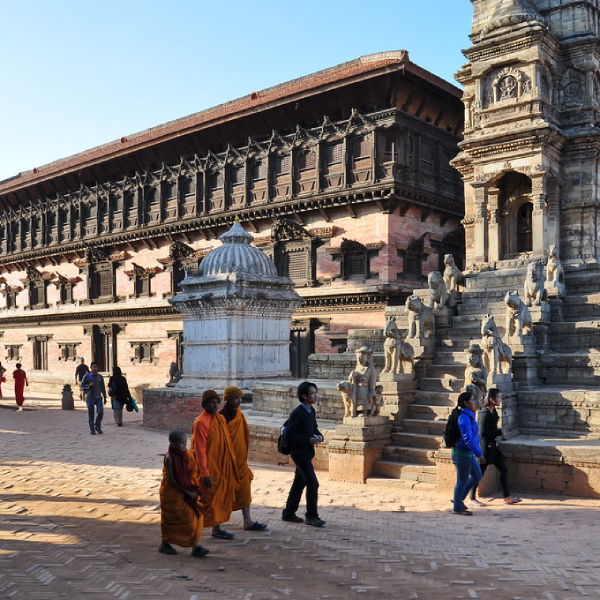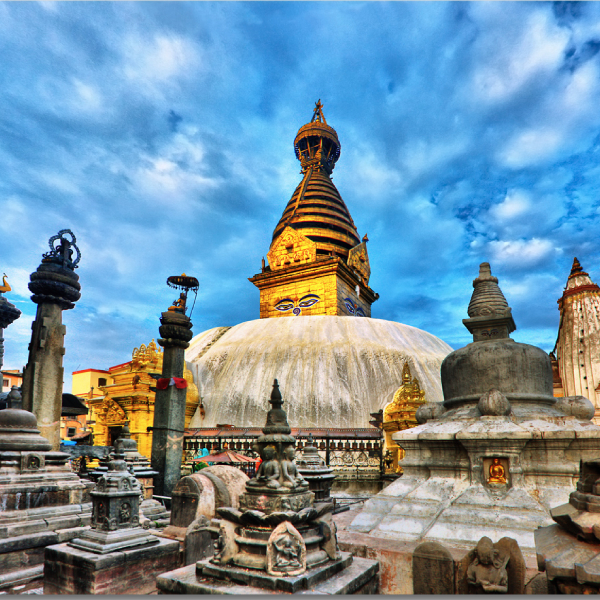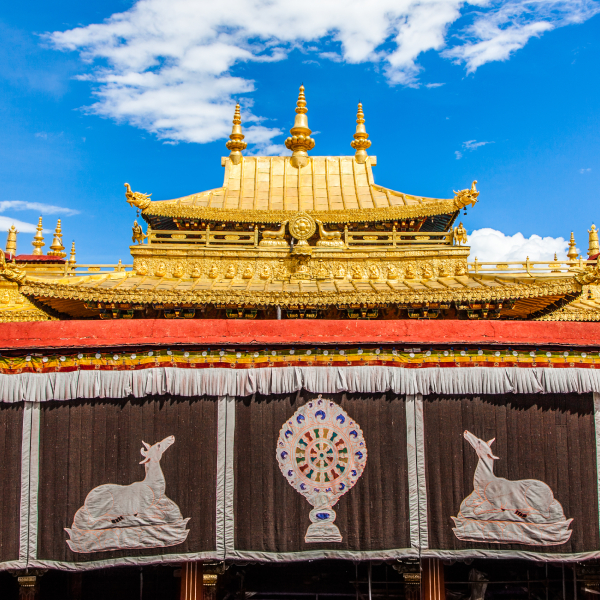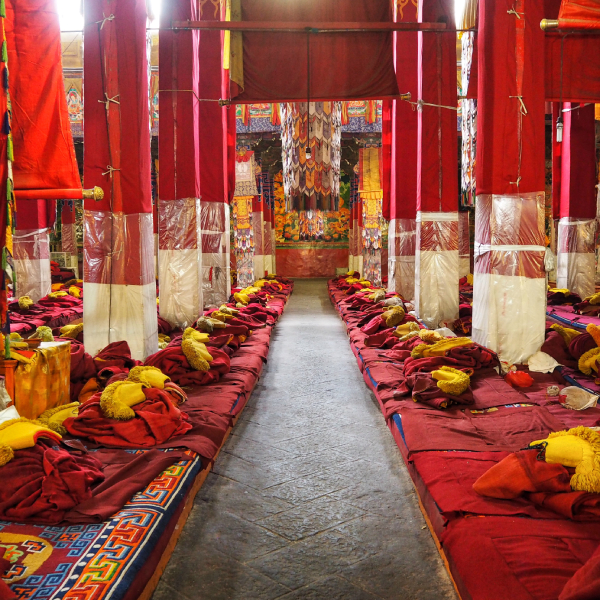Nepal & Tibet Combination Tour to Roof of the World 11 Night 12 Days
Nepal & Tibet Combination Tour to Roof of the World 11 Night 12 Days
Kathmandu, the capital city of Nepal, is a vibrant and culturally rich metropolis in the heart of the Kathmandu Valley. It's known for its ancient temples, bustling markets, and diverse heritage. The city offers a fusion of tradition and modernity, attracting travellers with its historical charm and spiritual significance.
Tibet, known as the "Roof of the World," is an autonomous region in China, renowned for its breathtaking Himalayan landscapes, including Mount Everest. Rich in Tibetan Buddhist culture and heritage, it captivates with monasteries, spiritual traditions, and captivating festivals. It's a land of profound spirituality, stunning vistas, and unique cultural experiences.
Short Itinerary
| Title | Accommodation | Meals |
| Day 1: Arrival in Kathmandu | Hotel | |
| Day 2: Full-day Sightseeing in Kathmandu | B/-/- | Hotel |
| Day 3: Full-day Sightseeing in Kathmandu | B/-/- | Hotel |
| Day 4: Fly to Lhasa | B/-/D | Hotel |
| Day 5: Full-day Sightseeing in Lhasa | B/-/D | Hotel |
| Day 6: Full-day Sightseeing in Lhasa | B/-/D | Hotel |
| Day 7: Drive to Shigatse via Yamdrok Lake and Gyantse | B/-/D | Hotel |
| Day 8: Drive to Shegar | B/-/D | Hotel |
| Day 9: Day Visit to Everest Base Camp and Return to Shigatse | B/-/D | Hotel |
| Day 10: Drive Back to Lhasa | B/-/D | Hotel |
| Day 11: Fly Back to Kathmandu and Transfer to Dhulikhel | B/-/- | Hotel |
| Day 12: Final Departure | B |
Tour Program
Expand AllUpon your arrival in Kathmandu, you will be transferred to your hotel.
Hotel
On the second day, after an early morning breakfast, we will embark on a full day of sightseeing, visiting Bhaktapur, Pashupatinath, and Boudhanath Stupa.
Bhaktapur Durbar Square is a historic site and UNESCO World Heritage Site located in Bhaktapur, Nepal. It is one of the three Durbar Squares in the Kathmandu Valley, alongside Kathmandu Durbar Square and Patan Durbar Square. Bhaktapur Durbar Square is renowned for its well-preserved ancient architecture, exquisite wood carvings, and rich cultural heritage. Notable landmarks to visit include the Nyatapola Temple, Bhairavnath Temple, and the 55 Windows Palace.
Pashupatinath Temple stands as a revered pilgrimage site and sacred sanctuary in Kathmandu, Nepal. This Hindu temple complex is dedicated to Lord Pashupatinath, an incarnation of Lord Shiva. Situated along the banks of the holy Bagmati River, the temple's stunning architecture, adorned with intricate carvings and golden spires, exudes spiritual significance. Pashupatinath is not only a place of worship but also a cultural centre where rituals, prayers, and cremations take place. Devotees and visitors alike gather here to seek blessings, engage in contemplation, and witness the timeless customs that embody Nepal's profound spiritual heritage.
Boudhanath Stupa, an iconic landmark in Kathmandu, Nepal, stands as a majestic testament to Buddhist spirituality and culture. This colossal stupa, one of the largest in Nepal, is a captivating blend of art and devotion. Its massive dome and spire, adorned with prayer flags and watchful eyes, create an aura of serenity and reverence. A hub of Tibetan Buddhist practices, Boudhanath draws pilgrims and visitors who circumambulate its base, spinning prayer wheels and chanting mantras. The surrounding area bustles with monasteries, shops, and cafes, offering a glimpse into the vibrant tapestry of Buddhist traditions that have thrived for centuries.
Hotel
B/-/-
On the third day, after an early morning breakfast, we will proceed with full-day sightseeing, visiting Kathmandu Durbar Square and Swayambhunath.
Kathmandu Durbar Square, located in the heart of Nepal's capital, is a historic and cultural hub that reflects the city's rich heritage. Adorned with stunning palaces, intricately carved wooden structures, and ancient temples, the square showcases Newar architecture at its finest. Once the royal palace of the Malla kings, the square exudes grandeur and artistic mastery. The Kumari Ghar, or Living Goddess Palace, is a prominent highlight, where the Kumari, a revered young girl selected as a living embodiment of the goddess Taleju, occasionally appears to bless visitors.
Swayambhunath Temple, often referred to as the "Monkey Temple," is a revered and ancient religious site located atop a hill in Kathmandu, Nepal. This iconic stupa holds immense cultural and spiritual significance for both Buddhists and Hindus. Its whitewashed dome and gilded spire are adorned with the watchful eyes of the Buddha, symbolizing wisdom and compassion. Surrounded by prayer flags and smaller shrines, the temple offers panoramic views of the Kathmandu Valley.
Hotel
B/-/-
Arriving in Lhasa is an extraordinary experience. After your flight, our representative will be there to assist you at the airport. You'll be heading to your hotel where you can relax and acclimatize to the high altitude. Lhasa, known as 'the land of the gods,' is the heart of Tibet and the capital of the Tibet Autonomous Region in China. This city is a treasure trove of Tibetan Buddhist heritage, set in a valley alongside the meandering Lhasa River. Over centuries, it has enticed travellers worldwide with its stunning landscapes, cultural richness, and an aura of mysticism that leaves a lasting impression on all who visit. Your journey in Lhasa promises to be an enchanting one.
Hotel
B/-/D
On the fifth day, following an early morning breakfast, we will embark on a full day of sightseeing, visiting Drepung Monastery and Sera Monastery.
Drepung Monastery is situated in the hills just outside Lhasa, Tibet, and stands as a remarkable testament to the spiritual and cultural significance of Tibetan Buddhism. Established in 1416, it was once home to over 10,000 monks, making it the largest Tibetan Buddhist monastery. The vast complex boasts striking white buildings, earning it the nickname "Monastery of Rice Heap" due to its appearance from a distance. Drepung is a central institution of the Gelug Sect and played a pivotal role in Tibetan religious and political history. Its rich traditions, intricate murals, and grand assembly halls continue to attract pilgrims, scholars, and travellers, offering a glimpse into Tibet's profound spiritual heritage.
Sera Monastery is an esteemed Tibetan Buddhist institution, located on the outskirts of Lhasa, Tibet. Founded in 1419, it is renowned for its stunning architecture, serene courtyards, and unique spiritual atmosphere. Sera was one of the "Great Three" Gelug monasteries, once housing thousands of monks. The highlight of Sera Monastery is the daily debate sessions, where monks engage in animated philosophical discussions. The monastery's assembly hall, chapels, and intricate murals showcase the depth of Tibetan Buddhist art and culture. Sera Monastery provides a captivating opportunity to experience Tibetan traditions, study Buddhism, and witness the monastic way of life, making it a must-visit destination for travellers interested in spirituality and history.
Hotel
B/-/D
On the sixth day, after an early morning breakfast, we will continue our full day of sightseeing, visiting the Potala Palace, Norbulinka, Jokhang, and Barkhor Market.
The Potala Palace is a UNESCO World Heritage site and stands as an iconic symbol of Tibet's cultural and spiritual legacy. Perched on Red Hill in Lhasa, Tibet, this architectural marvel was initially constructed in the 7th century and underwent significant expansion, notably by the 5th Dalai Lama in the 17th century. It boasts over a thousand rooms, featuring a fusion of Tibetan and Han Chinese architectural styles, making it a masterpiece of design. The Potala Palace served as the winter residence for successive Dalai Lamas and is rich in art, history, and religious relics. It remains an enduring emblem of Tibetan Buddhism and a pilgrimage destination for those seeking enlightenment and awe-inspiring vistas.
Norbulinka, often referred to as the "Jewel Park," is a tranquil and historic garden complex in Lhasa, Tibet. Built-in the 18th century, it served as the summer residence for the Dalai Lamas and was an essential center for Tibetan arts and culture. The site features stunning Tibetan architecture, lush gardens, and numerous palaces and pavilions. Norbulinka encapsulates the essence of Tibetan aesthetics and hosts festivals and performances that showcase traditional Tibetan opera, dance, and music. Visitors can explore its beautifully decorated rooms, sacred chapels, and museums, gaining profound insights into Tibetan heritage and the lives of the Dalai Lamas, making it a serene and culturally rich destination in Lhasa.
The Jokhang Temple is located in the heart of Lhasa, Tibet, and is one of the most sacred and revered religious sites in Tibetan Buddhism. Built in the 7th century by King Songtsen Gampo, it has served as a spiritual epicenter for over a millennium. Its unique blend of Tibetan and Indian architectural styles, intricate murals, and a statue of the 12-year-old Buddha are cherished by pilgrims and visitors alike. The temple complex is a bustling center for Tibetan Buddhist worship, with devout pilgrims circling it in a kora. Jokhang's spiritual aura, historical significance, and remarkable architecture make it a must-visit destination for those seeking to delve into Tibet's profound cultural and religious heritage.
Barkhor Market is a bustling ancient street encircling the Jokhang Temple in Lhasa, Tibet. It is a vibrant cultural and commercial hub that has served as a vital pilgrimage route and marketplace for centuries. Pilgrims and visitors walk the kora (circuit) around Jokhang Temple, spinning prayer wheels and engaging in spiritual practices. The market offers a rich tapestry of Tibetan culture, with shops selling traditional handicrafts, religious artifacts, and local cuisine. The scent of incense wafts through the air, and the colorful wares and devout pilgrims create an atmosphere that captures the essence of Tibetan heritage. Barkhor Market is a sensory journey into the heart of Lhasa's cultural and spiritual life.
Hotel
B/-/D
On the seventh day, we will drive to Shigatse via Yamdrok Lake and Gyantse.
Yamdrok Lake is one of Tibet's largest sacred lakes and is a mesmerizing body of water surrounded by snow-capped peaks. According to local legend, it's believed to be the transformation of a goddess. The lake is also home to a significant power station, completed in 1996.
The Palkhor Monastery in Gyantse is renowned for its architectural diversity and the harmonious coexistence of three different Buddhist sects. It's a fascinating blend of art, sculpture, and history, reflecting the collaboration between Newari and Tibetan artists. The Kumbum Stupa is an iconic structure and the centerpiece of the monastery, containing an impressive array of chapels and sculptures. The nine-story Kumbum pagoda, with its intricate design, is a testament to the artistic collaboration between Nepalese and Tibetan craftsmen. It's a place of deep cultural and artistic significance in Tibetan Buddhism.
Hotel
B/-/D
On the eighth day of your journey, after exploring the rich cultural heritage of Tashilunpo Monastery in Shigatse, Tibet, you'll continue your exploration. Founded in 1447 by the First Dalai Lama, this monastery holds a significant place as the traditional seat of the successive Panchen Lamas, the second highest-ranking tulku lineage in the Gelukpa tradition. Tashilunpo Monastery, which once housed over 4,000 monks in its prime, witnessed the Tibetan national uprising in 1959, leading to the exodus of many Tibetans, including monks from Tashilunpo Monastery to India. In recent years, parts of the monastery have been accessible to the public, attracting tourists interested in its rich history and culture.
En route to Shegar, you had the opportunity to visit the Shakya Monastery, which has a history dating back to 1073. This monastery is divided into Southern and Northern sections and holds historical treasures, including imperial certificates, gold signets, and a vast collection of Tibetan books. It's often referred to as "the second Dun Huang Cave," and these cultural and historical sites are of great importance to Tibet's history and spiritual heritage.
Hotel
B/-/D
On the ninth day of your journey, you'll embark on a day visit to the iconic Everest Base Camp (EBC), a destination that holds a special place for adventurers and mountaineers from around the world. The journey takes you from Rongbuk to EBC, a pilgrimage site that offers breathtaking views of Mount Everest. A scenic drive of approximately 1.5 hours brings you to Rongbuk Monastery, the gateway to EBC. From there, you have the option to either trek or take a quicker vehicle ride, which lasts about 15 minutes, to reach EBC.
As you ascend beyond Rongbuk, the landscape transitions into a vast glacial outwash plain. There's also an interesting shortcut from the monastery that takes you through a meadow and past the ancient meditation retreat ruins of Rong Chung. The road then winds through rocky and glacial terrain on the left side of the valley, passing by Sherab Choling Hermitage and offering opportunities to spot wildlife such as deer and yak.
After exploring EBC and taking in the majestic views of Mount Everest, you'll return to Shigatse, which is a drive that takes approximately 5-6 hours. This day is filled with awe-inspiring natural beauty and cultural insights in the heart of the Himalayas.
Hotel
B/-/D
On the tenth day, your journey continues in Shigatse, Tibet's second-largest city and the capital of the traditional Tibetan province of Tsang. Here, you'll visit the renowned Tashilhunpo Monastery, an iconic and culturally significant site in Tibet. Perched atop a hill in Shigatse, the name "Tashilhunpo" translates to "all fortune and happiness gathered here" or "heap of glory." Established by the First Dalai Lama in 1447, this monastery holds a special place as the traditional seat of the successive Panchen Lamas, the second highest-ranking tulku lineage in the Gelukpa tradition.
In its prime, Tashilhunpo Monastery was home to over 4,000 monks. However, during the Tibetan national uprising in 1959, a small group of monks and many Tibetans fled to India. In recent years, parts of Tashilhunpo Monastery have been open to the public, making it a significant and captivating tourist attraction, welcoming travellers to explore its rich history and culture. Afterwards, you'll head back to Lhasa, concluding your journey through Tibet.
Hotel
B/-/D
On the eleventh day, your journey continues as you're transferred to the airport for your flight back to Kathmandu. From there, you'll embark on a drive to Dhulikhel, an ancient Newari town nestled amidst picturesque hills and valleys. Situated at the foothills of the Pachkhal Valley, Dhulikhel is located about 21 miles east of Kathmandu on the Arniko Highway leading to Tibet. The 45-minute drive offers breathtaking views of the northeastern Himalayas and stunning pagoda-style temples.
Dhulikhel, a historic trade centre, is known for its natural beauty and tranquillity. It's renowned for its magnificent sunrise and sunset vistas, providing a panoramic view of the Himalayan ranges, from Cho Oyu in the east to Himalchuli in the west. The old town of Dhulikhel features traditional Newari architecture, with beautifully carved windows and doors. The area is dotted with temples and shrines, reflecting Dhulikhel's rich Newari heritage and craftsmanship. The cobbled streets and lanes create a charming atmosphere, making Dhulikhel a must-visit destination.
Hotel
B/-/-
After your breakfast, you will be transferred to the airport for your onward journey.
B
Tour Includes
Nepal Portion:
- Necessary arrival/ departure transfers with private transfers and representatives.
- 04 Nights hotel accommodation at Kathmandu on twin-sharing basis on a bed and breakfast plan.
- All sightseeing as indicated in the program with a private vehicle and escorted by an English-speaking local guide.
- All monument entrance fees.
Tibet Portion:
- All necessary arrival/departure transfers.
- Meet assistance at the airport.
- 07 Nights of hotel accommodation in a twin shared room on MAP plan.
- Sightseeing tour and all surface transfers in Tibet will be provided as per the itinerary with an English-speaking Tibetan guide by private vehicle.
- Tibet Travel Permit.
- All entrance and monument fees as indicated in the program.
Tour Excludes
- Nepal entry visa fee
- Chinese Visa Fee –As quoted separately
- International airfare and taxes [Quoted separately and is subject to change if revised].
- Meals which are not mentioned in the above program
- Refreshments, bottled drinks.
- Tipping.
- Insurance and rescue of any form.
- Cost arising out of flight cancellations/road blockades/landslides/riots, and events beyond our control.
- Expenses of a personal nature and any other expenses not mentioned in the above costs.
- Photography charges in the monasteries and monuments.
- Any items, services, and meals that are not included in the above cost inclusion or mentioned in the above itinerary
FAQ
Expand AllØ The tour lasts for 11 nights and 12 days.
Ø Highlights include exploring cultural sites in Kathmandu, such as Pashupatinath Temple and Boudhanath Stupa, and experiencing the awe-inspiring landscapes and ancient monasteries of Tibet.
Ø Transportation may involve a combination of flights and overland journeys, providing opportunities to witness stunning scenery along the way.
Ø Yes, accommodations in hotels or guesthouses are typically included for both destinations, ensuring comfortable stays throughout the tour.
Ø Generally, breakfast, lunch, and dinner are provided, either at the accommodations or at local restaurants along the route.
Ø The best times to visit are usually during the spring (April to June) and autumn (September to November) when the weather is pleasant, and cultural festivals are celebrated.
Ø Yes, as Tibet is at a high altitude, it's essential to acclimatize gradually to avoid altitude sickness.
Ø Pack clothing suitable for both warm and cool weather, comfortable walking shoes, sunscreen, sunglasses, and any necessary medications for altitude sickness.
Ø Yes, travel insurance that covers high-altitude travel, medical emergencies, and trip cancellations is highly recommended.
Ø Depending on the tour operator, customization options may be available. Discuss your preferences with the organizer.
Ø Yes, travellers need to obtain the necessary permits for both Nepal and Tibet, usually arranged by the tour operator.
Ø Yes, most tour packages include English-speaking guides who are knowledgeable about the local culture, history, and landmarks.
Ø It's advisable to carry a mix of Nepalese Rupee (NPR) for Nepal and Chinese Yuan (CNY) for Tibet for expenses along the route.
Ø Yes, photography is generally permitted, but it's respectful to ask for permission in sensitive areas or when photographing locals.
Ø Experienced guides, reliable transportation, and adherence to safety protocols ensure a safe and enjoyable experience while exploring the wonders of Nepal and Tibet, the "Roof of the World."
Things to know
- Travel Documents & Permits
- Nepal:
- Visa: On arrival for most nationalities (bring USD cash + passport photo).
- Tibet (China):
- Tibet Travel Permit (TTP): Mandatory; arranged by your tour operator in Kathmandu (requires passport + Chinese visa).
- Chinese Visa: Apply beforehand or in Kathmandu (allow 3-4 working days).
- Altitude & Acclimatization
- Critical Points:
- Lhasa (3,650m): Rest on Days 4–5 to adjust.
- Symptoms: Headache, nausea—hydrate, avoid alcohol, consider Diamox (consult doctor).
- Packing Essentials
- Clothing:
- Layered outfits (0°C to 20°C swings).
- Windproof jacket, warm hat, sunglasses (UV protection).
- Cultural Etiquette
- Tibet:
- Circumambulate stupas/prayer wheels clockwise.
- Never touch a monk’s head or point feet at altars.
- Nepal:
- Remove shoes before entering Hindu/Buddhist sites.
- Transport & Logistics
- Flights:
- Kathmandu → Lhasa: 1.5hrs; book window seats for Himalaya views.
- Road Travel:
- Private 4WD with driver/guide (mandatory in Tibet).
- Kathmandu-Lhasa Highway: Rough terrain; motion sickness pills advised.
- Money
- Currency:
- Nepal: NPR (ATMs in Kathmandu).
- Tibet: CNY (cash only in remote areas).
Why Book With Us?
- Expert Knowledge
- Customized Itineraries
- Immersive Experiences
- Seamless Travel
- Safety and Comfort
- Cultural Sensitivity
- Flexible Options
- Best Tour Guides
- Unmatched Hospitality
- Personalized Support
- Sustainable Tourism
- Local Partnerships



